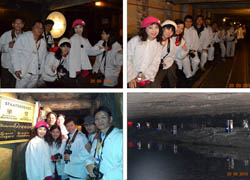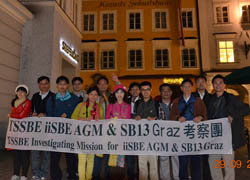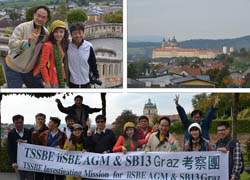Summary of iiSBE AGM & SB13 Graz (Part: 6)
 奧地利有三個鹽洞區,分別是:Salzwelten Salzburg、Salzwelten Altaussee、以及Salzwelten Hallstatt。本次參訪的是Salzwelten Salzburg。進入礦坑前必須先換上礦工裝,體驗礦工進入礦區乘坐的小火車(obersteinberg-stollen)在下滑坑道的木軌滑行,到地下深11.88公尺處參觀,支架立礦壁及鹽脈的情況,沿途可見一斑。礦工在地下11.88公尺處的高溫及稀薄空氣下工作是何等的辛苦。礦坑內不時以影片介紹鹽坑及採礦的歷史過程,加深對鹽洞的了解;現場布置並以人偶來還原當時史前時代岩鹽採掘的模擬狀況;另外洞內還有因礦災遭埋入岩壁,年代長久後形成的乾屍(Man in salt),當時所遺留下來採掘器具及失事現場也變成現今的珍貴古蹟。採鹽礦的工法也在每個礦區各造就了一座地下鹽湖,無風不動的湖面將湖底映射在湖面上,並輔以彩色燈光,呈現出夢幻形態。 奧地利有三個鹽洞區,分別是:Salzwelten Salzburg、Salzwelten Altaussee、以及Salzwelten Hallstatt。本次參訪的是Salzwelten Salzburg。進入礦坑前必須先換上礦工裝,體驗礦工進入礦區乘坐的小火車(obersteinberg-stollen)在下滑坑道的木軌滑行,到地下深11.88公尺處參觀,支架立礦壁及鹽脈的情況,沿途可見一斑。礦工在地下11.88公尺處的高溫及稀薄空氣下工作是何等的辛苦。礦坑內不時以影片介紹鹽坑及採礦的歷史過程,加深對鹽洞的了解;現場布置並以人偶來還原當時史前時代岩鹽採掘的模擬狀況;另外洞內還有因礦災遭埋入岩壁,年代長久後形成的乾屍(Man in salt),當時所遺留下來採掘器具及失事現場也變成現今的珍貴古蹟。採鹽礦的工法也在每個礦區各造就了一座地下鹽湖,無風不動的湖面將湖底映射在湖面上,並輔以彩色燈光,呈現出夢幻形態。Austria has three salt cave regions: Salzwelten Salzburg, Salzwelten Altaussee and Salzwelten Hallstatt. This time, we visited Salzwelten Salzburg. Before entering the mine everyone must change into miner clothing and then slide down into the mine along wooden rails on the small train (obersteinberg-stollen) that miners once used. We then toured the mine located 11.88 meters under the ground where the mining supports and salt veins everywhere. The high temperature and thin air 11.88 meters under the ground meant the miners had a very difficult job to do. Here and there in the mine were videos on the history of mining and the salt mine. Mannequins were also used to recreate how salt was mined in prehistoric mines. The mine featured a "man in salt" display formed after miners were buried by a cave-in. The digging tools left behind and scene of the accident itself are now a precious historic site. The technique used for salt mining led to the creation of an underground salt lake in each mining region as well. The way that the perfectly still lake surface reflected the lake bottom created a fantastic sight when combined with colored lighting.  結束今日的所有行程後,考察團一行轉往音樂神童莫札特的故鄉,奧地利第四大城薩爾斯堡(Salzburg)。 結束今日的所有行程後,考察團一行轉往音樂神童莫札特的故鄉,奧地利第四大城薩爾斯堡(Salzburg)。At the end of the day, the delegation continued on to Salzburg, the hometown of Mozart, the child music genius, and the fourth largest city in Austria. 2013年9月29日一早,考察團前往梅爾克修道院,修道院位於下奧地利州梅爾克鎮的山岩上,此處高約六十米,一面俯瞰多瑙河,比鄰瓦豪河谷,過去是羅馬帝國時代的軍事城堡,西元1702年至1736年由雅格布‧普蘭陶爾(Jakob Prandtauer)重新設計興建,修道院是巴洛克式建築的傑作,外觀為鵝黃與白相間的顏色,教堂東西長320公尺,高聳入雲的尖塔高65公尺,雕飾及造型非常獨特,遠觀十分宏偉。  On September 29, 2013, the delegation set off early in the morning for the Melk Abbey. The Abbey is situated on a rocky outcrop in the town of Melk, Niederoesterreich. The outcrop is 60 meters high, overlooks the Danube River and is close to the Wachau Valley. It was originally a Roman fort but was rebuilt between 1702 and 1736 AD by Jakob Prandtauer. The Abbey is a masterpiece of Baroque architecture in yellow and white. The church is 320 meters along its east-west axis and the tall tower is 65 meters high. It not only features distinctive carvings and designs but also is magnificent to behold from a distance. On September 29, 2013, the delegation set off early in the morning for the Melk Abbey. The Abbey is situated on a rocky outcrop in the town of Melk, Niederoesterreich. The outcrop is 60 meters high, overlooks the Danube River and is close to the Wachau Valley. It was originally a Roman fort but was rebuilt between 1702 and 1736 AD by Jakob Prandtauer. The Abbey is a masterpiece of Baroque architecture in yellow and white. The church is 320 meters along its east-west axis and the tall tower is 65 meters high. It not only features distinctive carvings and designs but also is magnificent to behold from a distance.教堂中金碧輝煌,處處鑲金,訴說著此處曾經歷的輝煌,也顯露其貴氣,因神聖羅馬帝國王室是主要贊助者,所以也以宗教影響力維持政局穩定,宗教對當時社會政治的影響從教堂內的擺飾即可窺見一二,雖教堂地處偏遠,但權貴絡繹於途,修士要在此富麗堂皇的教堂內隱修,恐怕是難隱也難修。 The interior of the church was very ornate with gold-plating everywhere, evidence of the Abbey's wealth and old glories. As the imperial family of the Holy Roman Empire was its main sponsor, the power of religion was used to ensure political stability as well. The influence of religion on the society and politics of the time can be seen from the decorations inside the church. Despite the church's remote location, it was frequently visited by the rich and powerful. It would not have been easy for monks to find quiet and solitude in such a magnificent church.  離開梅爾克修道院後前往杜倫斯坦(Duernstein),這個小鎮離維也納只有73公里,相傳在西元1192年,英國獅心王稱號的理查(Richard the Lionheart),因戰利品分配不滿意被奧地利公爵利奧波德五世秘密囚禁在山頂上的克恩林古堡(Kuenringer)裡。而現今遊歷其間,發現鎮內有著許多古建築及特色小店,店家主要販賣紀念品、巧克力、杏桃加工食品和酒,雖多瑙河在其旁,周邊風光明媚,存在古意與恬靜,但小鎮景觀相較奧地利其他城鎮並沒有明顯特色,只是加入歷史傳說,旅人遊歷其間,就可增添一些想像趣味,這似乎是提升古蹟價值,包裝行銷的最好方法。參觀完畢,考察團一行隨即轉往下榻維也納。 離開梅爾克修道院後前往杜倫斯坦(Duernstein),這個小鎮離維也納只有73公里,相傳在西元1192年,英國獅心王稱號的理查(Richard the Lionheart),因戰利品分配不滿意被奧地利公爵利奧波德五世秘密囚禁在山頂上的克恩林古堡(Kuenringer)裡。而現今遊歷其間,發現鎮內有著許多古建築及特色小店,店家主要販賣紀念品、巧克力、杏桃加工食品和酒,雖多瑙河在其旁,周邊風光明媚,存在古意與恬靜,但小鎮景觀相較奧地利其他城鎮並沒有明顯特色,只是加入歷史傳說,旅人遊歷其間,就可增添一些想像趣味,這似乎是提升古蹟價值,包裝行銷的最好方法。參觀完畢,考察團一行隨即轉往下榻維也納。After leaving the Melk Abbey, we continued on to Duernstein. This small town is just 73 km from Vienna and the legends say that in 1192 A.D., Richard the Lionheart, the King of England, was secretly imprisoned in the old Kuenringer castle at the top of the mountain by Leopold V, the Duke of Austria, after falling out over how the spoils of war were to be divided. During our tour, we discovered many old buildings and specialty shops in the town that mainly sold souvenirs, chocolates as well as almond-based foods and wine. Despite the nearby Danube River, picturesque scenery, idyllic atmosphere and sense of history, the townscape seemed rather mundane compared to other Austrian towns. The addition of historical legends however added interest for visitors and appeared to be the best way of packaging and marketing historic sites. When the tour was finished, the delegation went on to stay at Vienna. |

